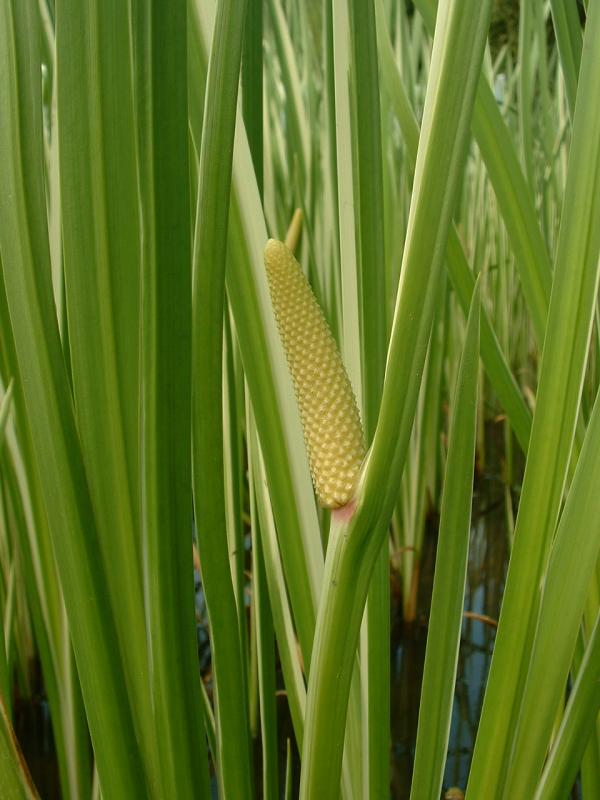- Sweet Flag
Taxobox
name = Common Sweet Flag

image_width = 250px
image_caption = Sweet flag
regnum =Plant ae
divisio = Magnoliophyta
classis =Liliopsida
ordo =Acorales
familia =Araceae
genus = "Acorus "
species = "A. calamus"
binomial = "Acorus calamus"
binomial_authority = L.Calamus or Common Sweet Flag ("Acorus calamus") is a
plant from theAcoraceae family,Acorus genues. It is a tall perennialwetland monocot withscent ed leaves andrhizome s which have been used medicinally, for its odor, and as a psychotropic drug. It is known by a variety of names, including cinnamon sedge, flagroot, gladdon, myrtle flag, myrtle grass, myrtle sedge, sweet cane, sweet myrtle, sweet root, sweet rush, and sweet sedge. ItsSanskrit name is "vacha". [Ramawat, K. G., Ed. (2004). "Biotechnology of Medicinal Plants: Vitalizer and Therapeutic" Enfield, New Hampshire: Science Publishers, Inc. 5.] Probably indigenous toIndia , "Acorus calamus" is now found across Europe, in southern Russia, northern Asia Minor, southern Siberia, China, Japan, Burma, Sri Lanka, Australia, southern Canada and northern USA.Botanical information
The morphological distinction between the "Acorus" species is made by the number of prominent
leaf veins. "Acorus calamus" has a single prominent midvein and then on both sides slightly raised secondary veins (with a diameter less than half the midvein) and many, fine tertiary veins. This makes it clearly distinct from "Acorus americanus".The leaves are between 0.7 and 1.7 cm wide, with average of 1 cm. The sympodial leaf of "Acorus calamus" is somewhat shorter than the vegetative leaves. The margin is curly-edged or undulate. The
spadix , at the time of expansion, can reach a length between 4.9 and 8.9 cm (longer than "A. americanus"). The flowers are longer too, between 3 and 4 mm. "Acorus calamus" is infertile and shows an abortive ovary with a shriveled appearance.Chemistry
Both triploid and tetraploid calamus contain
asarone , but diploid does not contain any.Regulations
Calamus and products derived from calamus (such as its oil) were banned in 1968 as food additives and medicines by the
United States Food and Drug Administration .Usage
Calamus has been an item of trade in many cultures for thousands of years. Calamus has been used medicinally for a wide variety of ailments and its smell makes calamus essential oil valued in the perfume industry [ [http://www.botanical.com/botanical/mgmh/s/sedges39.html botanical.com - A Modern Herbal | Sedge, Sweet ] ] .
In antiquity in the Orient and Egypt, the rhizome was thought to be a powerful aphrodisiac. In Europe "Acorus calamus" was often added to wine, and the root is also one of the possible ingredients of
absinthe . Among the northern Native Americans, it is used both medicinally and as astimulant ; in addition, the root is thoughtwho to have been used as anentheogen among the northern Native Americans. In high doses, it is hallucinogenic. Acorus calamus shows neuroprotective effect against stroke and chemical induced neurodegeneration in rat. Specifically, it has protective effect against acrylamide induced neurotoxicity.Shukla PK, Khanna VK, Ali MM, Maurya R, Khan MY, Srimal RC. Neuroprotective effect of Acorus calamus against middle cerebral artery occlusion-induced ischaemia in rat. Hum Exp Toxicol. 2006 Apr;25(4):187-94.PMID: 16696294 Shukla PK, Khanna VK, Ali MM, Maurya RR, Handa SS, Srimal RC. Protective effect of acorus calamus against acrylamide induced neurotoxicity.Phytother Res. 2002 May;16(3):256-60.PMID: 12164272The plant's roots are often eaten for its effects, which are not very pronounced. Hence, Sweet Flag is not seen as a party drug.
Cultural symbolism
The calamus has long been a symbol of male love. The name is associated with a Greek myth:
Kalamos , a son of the river-godMaeander , who lovedKarpos , the son ofZephyrus andChloris . When Karpos drowned, Kalamos was transformed into a reed, whose rustling in the wind was interpreted as a sigh of lamentation.The plant was a favorite of
Henry David Thoreau (who called it sweet flag), and also ofWalt Whitman , who added a section called the "Calamus" poems, possibly celebrating his love of men, to the third edition of "Leaves of Grass " (1860). In the poems the calamus is used as a symbol of love, lust, and affection. It has been suggested that the symbology derives from the visual resemblance of the spadix to the erect human penis.The name "Sweet Flag" refers to its sweet scent (it has been used as a
strewing herb ) and the wavy edges of the leaves which are supposed to resemble a fluttering flag.In Japan, the plant is a symbol of the
samurai 's bravery because of its sharp sword-like leaves. Even now many families with young boys enjoy "Sweet Flag Bath (shōbu yu)" in the Boy's Festival (Tango no Sekku) onMay 5 . Also, the legendary Japanese swordKusanagi was said to resemble a calamus.Etymology of the word Calamus
Cognate s of theLatin word "Calamus" are found in both Greek ("kalamos ", meaning "reed") andSanskrit ("kalama", meaning "reed" and "pen" as well as a sort of rice) — strong evidence that the word is older than all three languages and exists in their parent language,Proto-Indo European . The Arabic word "qalam" (meaning "pen") is likely to have been borrowed from one of these languages in antiquity, or directly from Indo-European itself.From the Latin root "calamus", a number of modern English words arise:
*calamari , meaning "squid", via theLatin "calamarium", "ink horn" or "pen case", as reeds were then used as writing implements;
* "calumet", another name for the Native Americanpeace pipe , which was often made from a hollow reed;
*shawm , a medievaloboe -like instrument (whose sound is produced by a vibrating reed mouthpiece);
* "chalumeau" register, the lower notes of aclarinet 's range (anotherreed instrument ).References
External links
* [http://delta-intkey.com/angio/www/araceae.htm Family Araceae] in [http://delta-intkey.com/angio/ L. Watson and M.J. Dallwitz (1992 onwards). The families of flowering plants: descriptions, illustrations, identification, information retrieval.] http://delta-intkey.com
* [http://www.fda.gov/bbs/topics/NEWS/ephedra/warningsample.html FDA street drug alternative warning letter]
* [http://www.pfaf.org/database/plants.php?Acorus+calamus "Acorus calamus" at Plants for a Future]
* [http://www.allaboutherbs.org/calamus-acorus-calamus Calamus Acorus Calamus Online Herb Guide]
Wikimedia Foundation. 2010.
